Global Variability and Future Projections of Marine Heatwave Onset and Decline Rates
Abstract
1. Introduction
2. Materials and Methods
2.1. OISST V2.1
2.2. CMIP6
2.3. Definition and Characteristics of Marine Heatwaves
3. Results
3.1. Spatial Distribution of Marine Heatwave Onset and Decline Rates in Historical Periods
3.2. Spatiotemporal Distribution of Changes in Onset and Decay Rates of Marine Heatwaves During the Historical Period
3.3. Spatial Distribution Features of MHW Onset and Decline Rates in Future
3.4. Spatiotemporal Characteristics of Future Trends in MHW Onset and Decline Rates
4. Discussion
5. Conclusions
Author Contributions
Funding
Data Availability Statement
Acknowledgments
Conflicts of Interest
Abbreviations
| MHW | Marine Heatwave |
| WTP | Western tropical oceans |
| NPG | North Pacific gyre |
| NAG | North Atlantic gyre |
| SIG | Southern Indian Ocean gyre |
| SPG | South Pacific gyre |
| Max/Min | Maximum/Minimum |
| ENSO | El Niño-Southern Oscillation |
| SST | Sea Surface Temperature |
| SAG | South Atlantic gyre |
| KOE | Kuroshio-Oyashio Extension |
| GS | Gulf Stream |
| BMC | Brazil-Malvinas Confluence |
| ACC | Antarctic Circumpolar Current |
| CMIP6 | Coupled Model Intercomparison Project Phase 6 |
| SSP245/585 | Shared Socio-economic Pathway 2/5-Representative Concentration Pathway 4.5/8.5 |
References
- Hoegh-Guldberg, O.; Bruno, J.F. The impact of climate change on the world’s marine ecosystems. Science 2010, 328, 1523–1528. [Google Scholar] [CrossRef]
- Poloczanska, E.S.; Brown, C.J.; Sydeman, W.J.; Kiessling, W.; Schoeman, D.S.; Moore, P.J.; Brander, K.; Bruno, J.F.; Buckley, L.B.; Burrows, M.T.; et al. Global imprint of climate change on marine life. Nat. Clim. Change 2013, 3, 919–925. [Google Scholar] [CrossRef]
- Graham, N.A.J.; Jennings, S.; MacNeil, M.A.; Mouillot, D.; Wilson, S.K. Predicting climate-driven regime shifts versus rebound potential in coral reefs. Nature 2015, 518, 94–97. [Google Scholar] [CrossRef]
- Pecl, G.T.; Araújo, M.B.; Bell, J.D.; Blanchard, J.; Bonebrake, T.C.; Chen, I.-C.; Clark, T.D.; Colwell, R.K.; Danielsen, F.; Evengård, B.; et al. Biodiversity redistribution under climate change: Impacts on ecosystems and human well-being. Science 2017, 355, eaai9214. [Google Scholar] [CrossRef] [PubMed]
- Pinsky, M.L.; Selden, R.L.; Kitchel, Z.J. Climate-driven shifts in marine species ranges: Scaling from organisms to communities. Annu. Rev. Mar. Sci. 2020, 12, 153–179. [Google Scholar] [CrossRef]
- Chimienti, G.; De Padova, D.; Adamo, M.; Mossa, M.; Bottalico, A.; Lisco, A.; Ungaro, N.; Mastrototaro, F. Effects of global warming on Mediterranean coral forests. Sci. Rep. 2021, 11, 20703. [Google Scholar] [CrossRef]
- IPCC. Summary for Policymakers. In Climate Change 2021: The Physical Science Basis. Contribution of Working Group I to the Sixth Assessment Report of the Intergovernmental Panel on Climate Change; Cambridge University Press: Cambridge, UK, 2021; Available online: https://www.ipcc.ch/report/ar6/wg1/chapter/summary-for-policymakers/ (accessed on 3 February 2025).
- Frölicher, T.L.; Fischer, E.M.; Gruber, N. Marine heatwaves under global warming. Nature 2018, 560, 360–364. [Google Scholar] [CrossRef]
- Liu, X.; Peng, Y.; Xu, Y.; He, G.; Liang, J.; Masanja, F.; Yang, K.; Xu, X.; Deng, Y.; Zhao, L. Responses of digestive metabolism to marine heatwaves in pearl oysters. Mar. Pollut. Bull. 2023, 186, 114395. [Google Scholar] [CrossRef] [PubMed]
- Yan, W.; Wang, Z.; Pei, Y.; Zhou, B. How does ocean acidification affect Zostera marina during a marine heatwave? Mar. Pollut. Bull. 2023, 194, 115394. [Google Scholar] [CrossRef]
- Wolf, K.; Hoppe, C.; Rehder, L.; Schaum, C.E.; John, U.; Rost, B. Heatwave responses of Arctic phytoplankton communities are driven by combined impacts of warming and cooling. Sci. Adv. 2024, 10, eadl5904. [Google Scholar] [CrossRef]
- Berger, A.C.; Berg, P. Eelgrass meadow response to heat stress. I. Temperature threshold for ecosystem production derived from in situ aquatic eddy covariance measurements. Mar. Ecol. Prog. Ser. 2024, 736, 35–46. [Google Scholar] [CrossRef]
- Stipcich, P.; Pansini, A.; Ceccherelli, G. Resistance of posidonia oceanic seedlings to warming: Investigating the importance of the lag-phase duration between two heat events to thermo-priming. Mar. Pollut. Bull. 2024, 204, 116515. [Google Scholar] [CrossRef]
- Oliver, E.C.J.; Donat, M.G.; Burrows, M.T.; Moore, P.J.; Smale, D.A.; Alexander, L.V.; Benthuysen, J.A.; Feng, M.; Sen Gupta, A.; Hobday, A.J.; et al. Longer and more frequent marine heatwaves over the past century. Nat. Commun. 2018, 9, 1324. [Google Scholar] [CrossRef]
- Yao, Y.; Wang, C.; Fu, Y. Global marine heatwaves and cold-spells in present climate to future projections. Earth’s Future 2022, 10, e2022EF002787. [Google Scholar] [CrossRef]
- Yang, Y.; Sun, W.; Yang, J.; Lim Kam Sian, K.T.C.; Ji, J.; Dong, C. Analysis and prediction of marine heatwaves in the Western North Pacific and Chinese coastal region. Front. Mar. Sci. 2022, 9, 1048557. [Google Scholar] [CrossRef]
- Sun, W.; Yin, L.; Pei, Y.; Shen, C.; Yang, Y.; Ji, J.; Yang, J.; Dong, C. Marine heatwaves in the Western North Pacific Region: Historical characteristics and future projections. Deep Sea Res. Part I 2023, 200, 104161. [Google Scholar] [CrossRef]
- Sun, W.; Yang, Y.; Wang, Y.; Yang, J.; Ji, J.; Dong, C. Characterization and future projection of marine heatwaves under climate change in the South China Sea. Ocean Model. 2024, 188, 102322. [Google Scholar] [CrossRef]
- Oliver, E.C.J.; Burrows, M.T.; Donat, M.G.; Sen Gupta, A.; Alexander, L.V.; Perkins-Kirkpatrick, S.E.; Benthuysen, J.A.; Hobday, A.J.; Holbrook, N.J.; Moore, P.J.; et al. Projected marine heatwaves in the 21st century and the potential for ecological impact. Front. Mar. Sci. 2019, 6, 734. [Google Scholar] [CrossRef]
- Jacox, M.G.; Alexander, M.A.; Bograd, S.J.; Scott, J.D. Thermal displacement by marine heatwaves. Nature 2020, 584, 82–86. [Google Scholar] [CrossRef]
- Cheung, W.W.L.; Frölicher, T.L. Marine heatwaves exacerbate climate change impacts for fisheries in the northeast Pacific. Sci. Rep. 2020, 10, 6678. [Google Scholar] [CrossRef]
- Arafeh-Dalmau, N.; Schoeman, D.S.; Montaño-Moctezuma, G.; Micheli, F.; Rogers-Bennett, L.; Olguin-Jacobson, C.; Possingham, H.P. Marine heat waves threaten kelp forests. Science 2020, 367, 635. [Google Scholar] [CrossRef] [PubMed]
- Smith, K.E.; Burrows, M.T.; Hobday, A.J.; Sen Gupta, A.; Moore, P.J.; Thomsen, M.; Wernberg, T.; Smale, D.A. Socioeconomic impacts of marine heatwaves: Global issues and opportunities. Science 2021, 374, eabj3593. [Google Scholar] [CrossRef]
- Donovan, M.K.; Burkepile, D.E.; Kratochwill, C.; Shlesinger, T.; Sully, S.; Oliver, T.A.; Hodgson, G.; Freiwald, J.; van Woesik, R. Local conditions magnify coral loss after marine heatwaves. Science 2021, 372, 977–980. [Google Scholar] [CrossRef] [PubMed]
- Fox, M.D.; Cohen, A.L.; Rotjan, R.D.; Mangubhai, S.; Sandin, S.A.; Smith, J.E.; Thorrold, S.R.; Dissly, L.; Mollica, N.R.; Obura, D. Increasing coral reef resilience through successive marine heatwaves. Geophys. Res. Lett. 2021, 48, e2021GL094128. [Google Scholar] [CrossRef]
- Jiang, M.; Gao, L.; Huang, R.; Lin, X.; Gao, G. Differential responses of bloom-forming Ulva intestinalis and economically important Gracilariopsis lemaneiformis to marine heatwaves under changing nitrate conditions. Sci. Total Environ. 2022, 840, 156591. [Google Scholar] [CrossRef]
- Hughes, T.P.; Kerry, J.T.; Álvarez-Noriega, M.; Álvarez-Romero, J.G.; Anderson, K.D.; Baird, A.H.; Babcock, R.C.; Beger, M.; Bellwood, D.R.; Berkelmans, R.; et al. Global warming and recurrent mass bleaching of corals. Nature 2017, 543, 373–377. [Google Scholar] [CrossRef] [PubMed]
- Eakin, C.M.; Sweatman, H.P.A.; Brainard, R.E. The 2014–2017 global-scale coral bleaching event: Insights and impacts. Coral Reefs 2019, 38, 539–545. [Google Scholar] [CrossRef]
- Hughes, T.P.; Kerry, J.T.; Baird, A.H.; Connolly, S.R.; Dietzel, A.; Eakin, C.M.; Heron, S.F.; Hoey, A.S.; Hoogenboom, M.O.; Liu, G.; et al. Global warming transforms coral reef assemblages. Nature 2018, 556, 492–496. [Google Scholar] [CrossRef]
- Cetina-Heredia, P.; Allende-Arandía, M.E. Caribbean marine heatwaves, marine cold spells, and co-occurrence of bleaching events. J. Geophys. Res. Oceans 2023, 128, e2023JC020147. [Google Scholar] [CrossRef]
- Douglas, A.E. Coral bleaching––how and why? Mar. Pollut. Bull. 2003, 46, 385–392. [Google Scholar] [CrossRef]
- Middlebrook, R.; Hoegh-Guldberg, O.; Leggat, W. The effect of thermal history on the susceptibility of reef-building corals to thermal stress. J. Exp. Biol. 2008, 211, 1050–1056. [Google Scholar] [CrossRef] [PubMed]
- Holbrook, N.J.; Sen Gupta, A.; Oliver, E.C.J.; Hobday, A.J.; Benthuysen, J.A.; Scannell, H.A.; Smale, D.A.; Wernberg, T. Keeping pace with marine heatwaves. Nat. Rev. Earth Environ. 2020, 1, 482–493. [Google Scholar] [CrossRef]
- Lybolt, M.; Neil, D.; Zhao, J.; Feng, Y.; Yu, K.-F.; Pandolfi, J. Instability in a marginal coral reef: The shift from natural variability to a human-dominated seascape. Front. Ecol. Environ. 2011, 9, 154–160. [Google Scholar] [CrossRef]
- Leggat, W.P.; Camp, E.F.; Suggett, D.J.; Heron, S.F.; Fordyce, A.J.; Gardner, S.; Deakin, L.; Turner, M.; Beeching, L.J.; Kuzhiumparambil, U.; et al. Rapid coral decay is associated with marine heatwave mortality events on reefs. Curr. Biol. 2019, 29, 2723–2730.e2724. [Google Scholar] [CrossRef]
- Descombes, P.; Wisz, M.S.; Leprieur, F.; Parravicini, V.; Heine, C.; Olsen, S.M.; Swingedouw, D.; Kulbicki, M.; Mouillot, D.; Pellissier, L. Forecasted coral reef decline in marine biodiversity hotspots under climate change. Glob. Change Biol. 2015, 21, 2479–2487. [Google Scholar] [CrossRef]
- Perry, A.L.; Low, P.J.; Ellis, J.R.; Reynolds, J.D. Climate change and distribution shifts in marine fishes. Science 2005, 308, 1912–1915. [Google Scholar] [CrossRef] [PubMed]
- Lima, F.; Ribeiro, P.; Queiroz, N.; Hawkins, S.; Santos, A. Do distribution shifts of northern and southern species of algae match the warming pattern? Glob. Change Biol. 2007, 13, 2592–2604. [Google Scholar] [CrossRef]
- Beaugrand, G.; Edwards, M.; Brander, K.; Luczak, C.; Ibanez, F. Causes and projections of abrupt climate-driven ecosystem shifts in the North Atlantic. Ecol. Lett. 2008, 11, 1157–1168. [Google Scholar] [CrossRef]
- Liu, G.; Strong, A.E.; Skirving, W. Remote sensing of sea surface temperatures during 2002 Barrier Reef coral bleaching. Eos. Trans. Amer. Geophys. Union 2003, 84, 137–141. [Google Scholar] [CrossRef]
- Bainbridge, S.J. Temperature and light patterns at four reefs along the Great Barrier Reef during the 2015–2016 austral summer: Understanding patterns of observed coral bleaching. J. Oper. Oceanogr. 2017, 10, 16–29. [Google Scholar] [CrossRef]
- Maynard, J.A.; Anthony, K.R.N.; Marshall, P.A.; Masiri, I. Major bleaching events can lead to increased thermal tolerance in corals. Mar. Biol. 2008, 155, 173–182. [Google Scholar] [CrossRef]
- Hobday, A.J.; Alexander, L.V.; Perkins, S.E.; Smale, D.A.; Straub, S.C.; Oliver, E.C.J.; Benthuysen, J.A.; Burrows, M.T.; Donat, M.G.; Feng, M.; et al. A hierarchical approach to defining marine heatwaves. Prog. Oceanogr. 2016, 141, 227–238. [Google Scholar] [CrossRef]
- Li, X.; Donner, S.D. Lengthening of warm periods increased the intensity of warm-season marine heatwaves over the past 4 decades. Clim. Dyn. 2022, 59, 2643–2654. [Google Scholar] [CrossRef]
- Sahin, D.; Schoepf, V.; Filbee-Dexter, K.; Thomson, D.P.; Radford, B.; Wernberg, T. Heating rate explains species-specific coral bleaching severity during a simulated marine heatwave. Mar. Ecol. Prog. Ser. 2023, 706, meps14246. [Google Scholar] [CrossRef]
- Bernal, M.A.; Schunter, C.; Lehmann, R.; Lightfoot, D.J.; Allan, B.J.M.; Veilleux, H.D.; Rummer, J.L.; Munday, P.L.; Ravasi, T. Species-specific molecular responses of wild coral reef fishes during a marine heatwave. Sci. Adv. 2020, 6, eaay3423. [Google Scholar] [CrossRef]
- Hemraj, D.A.; Posnett, N.C.; Minuti, J.J.; Firth, L.B.; Russell, B.D. Survived but not safe: Marine heatwave hinders metabolism in two gastropod survivors. Mar. Environ. Res. 2020, 162, 105117. [Google Scholar] [CrossRef]
- Sorte, C.J.B.; Fuller, A.; Bracken, M.E.S. Impacts of a simulated heat wave on composition of a marine community. Oikos 2010, 119, 1909–1918. [Google Scholar] [CrossRef]
- Wernberg, T.; Bennett, S.; Babcock, R.C.; de Bettignies, T.; Cure, K.; Depczynski, M.; Dufois, F.; Fromont, J.; Fulton, C.J.; Hovey, R.K.; et al. Climate-driven regime shift of a temperate marine ecosystem. Science 2016, 353, 169–172. [Google Scholar] [CrossRef] [PubMed]
- Wang, Q.; Zhang, B.; Zeng, L.; He, Y.; Wu, Z.; Chen, J. Properties and drivers of marine heat waves in the Northern South China Sea. J. Phys. Oceanogr. 2022, 52, 917–927. [Google Scholar] [CrossRef]
- Guo, X.; Gao, Y.; Zhang, S.; Wu, L.; Chang, P.; Cai, W.; Zscheischler, J.; Leung, L.R.; Small, J.; Danabasoglu, G.; et al. Threat by marine heatwaves to adaptive large marine ecosystems in an eddy-resolving model. Nat. Clim. Change 2022, 12, 179–186. [Google Scholar] [CrossRef]
- He, Q.; Zhan, W.; Feng, M.; Gong, Y.; Cai, S.; Zhan, H. Common occurrences of subsurface heatwaves and cold spells in ocean eddies. Nature 2024, 634, 1111–1117. [Google Scholar] [CrossRef] [PubMed]
- Spillman, C.M.; Smith, G.A.; Hobday, A.J.; Hartog, J.R. Onset and decline rates of marine heatwaves: Global trends, seasonal forecasts and marine management. Front. Clim. 2021, 3, 801217. [Google Scholar] [CrossRef]
- Reynolds, R.W.; Smith, T.M.; Liu, C.; Chelton, D.B.; Casey, K.S.; Schlax, M.G. Daily high-resolution-blended analyses for sea surface temperature. J. Clim. 2007, 20, 5473–5496. [Google Scholar] [CrossRef]
- Huang, B.; Liu, C.; Banzon, V.; Freeman, E.; Graham, G.; Hankins, B.; Smith, T.; Zhang, H.-M. Improvements of the daily optimum interpolation sea surface temperature (DOISST) Version 2.1. J. Clim. 2021, 34, 2923–2939. [Google Scholar] [CrossRef]
- Plecha, S.M.; Soares, P.M.M. Global marine heatwave events using the new CMIP6 multi-model ensemble: From shortcomings in present climate to future projections. Environ. Res. Lett. 2020, 15, 124058. [Google Scholar] [CrossRef]
- Yan, Y.; Chai, F.; Xue, H.; Wang, G. Record-breaking sea surface temperatures in the Yellow and East China Seas. J. Geophys. Res. Oceans 2020, 125, e2019JC015883. [Google Scholar] [CrossRef]
- Costa, N.V.; Rodrigues, R.R. Future summer marine heatwaves in the Western South Atlantic. Geophys. Res. Lett. 2021, 48, e2021GL094509. [Google Scholar] [CrossRef]
- Hayashi, M.; Shiogama, H.; Emori, S.; Ogura, T.; Hirota, N. The northwestern Pacific warming record in august 2020 occurred under anthropogenic forcing. Geophys. Res. Lett. 2021, 48, e2020GL090956. [Google Scholar] [CrossRef]
- Chiswell, S.M. Global trends in marine heatwaves and cold spells: The impacts of fixed versus changing baselines. J. Geophys. Res. Oceans 2022, 127, e2022JC018757. [Google Scholar] [CrossRef]
- Jacox, M.G.; Alexander, M.A.; Amaya, D.; Becker, E.; Bograd, S.J.; Brodie, S.; Hazen, E.L.; Pozo Buil, M.; Tommasi, D. Global seasonal forecasts of marine heatwaves. Nature 2022, 604, 486–490. [Google Scholar] [CrossRef]
- Li, Y.; Ren, G.; Wang, Q.; Mu, L.; Niu, Q. Marine heatwaves in the South China Sea: Tempo-spatial pattern and its association with large-scale circulation. Remote Sens. 2022, 14, 5829. [Google Scholar] [CrossRef]
- Yao, Y.; Wang, C. Marine heatwaves and cold-spells in global coral reef zones. Prog. Oceanogr. 2022, 209, 102920. [Google Scholar] [CrossRef]
- Zhang, X.; Zheng, F.; Zhu, J.; Chen, X. Observed frequent occurrences of marine heatwaves in most ocean regions during the last two decades. Adv. Atmos. Sci. 2022, 39, 1579–1587. [Google Scholar] [CrossRef]
- Sun, W.; Zhou, S.; Yang, J.; Gao, X.; Ji, J.; Dong, C. Artificial intelligence forecasting of marine heatwaves in the South China Sea using a combined U-Net and ConvLSTM system. Remote Sens. 2023, 15, 4068. [Google Scholar] [CrossRef]
- Sun, W.; Wang, Y.; Yang, Y.; Yang, J.; Ji, J.; Dong, C. Marine heatwaves/cold-spells associated with mixed layer depth variation globally. Geophys. Res. Lett. 2024, 51, e2024GL112325. [Google Scholar] [CrossRef]
- Wang, Y.; Zhang, C.; Tian, S.; Chen, Q.; Li, S.; Zeng, J.; Wei, Z.; Xie, S. Seasonal cycle of marine heatwaves in the northern South China Sea. Clim. Dyn. 2023, 61, 3367–3377. [Google Scholar] [CrossRef]
- Qiu, Z.; Qiao, F.; Jang, C.J.; Zhang, L.; Song, Z. Evaluation and projection of global marine heatwaves based on CMIP6 models. Deep Sea Res. Part II 2021, 194, 104998. [Google Scholar] [CrossRef]
- Zhang, S.; Chen, J. Uncertainty in projection of climate extremes: A comparison of CMIP5 and CMIP6. J. Meteorol. Res. 2021, 35, 646–662. [Google Scholar] [CrossRef]
- Wei, M.; Shu, Q.; Song, Z.; Song, Y.; Yang, X.; Guo, Y.; Li, X.; Qiao, F. Could CMIP6 climate models reproduce the early-2000s global warming slowdown? Sci. China Earth Sci. 2021, 64, 853–865. [Google Scholar] [CrossRef]
- Hamed, M.M.; Nashwan, M.S.; Shiru, M.S.; Shahid, S. Comparison between CMIP5 and CMIP6 models over MENA region using historical simulations and future projections. Sustainability 2022, 14, 10375. [Google Scholar] [CrossRef]
- Kajtar, J.B.; Hernaman, V.; Holbrook, N.J.; Petrelli, P. Tropical western and central Pacific marine heatwave data calculated from gridded sea surface temperature observations and CMIP6. Data Brief 2022, 40, 107694. [Google Scholar] [CrossRef]
- Scafetta, N. CMIP6 GCM ensemble members versus global surface temperatures. Clim. Dyn. 2023, 60, 3091–3120. [Google Scholar] [CrossRef]
- Li, X.; Donner, S. Assessing future projections of warm-season marine heatwave characteristics with three CMIP6 models. J. Geophys. Res. Oceans 2023, 128, e2022JC019253. [Google Scholar] [CrossRef]
- Eyring, V.; Bony, S.; Meehl, G.A.; Senior, C.A.; Stevens, B.; Stouffer, R.J.; Taylor, K.E. Overview of the coupled model intercomparison project phase 6 (CMIP6) experimental design and organization. Geosci. Model Dev. 2016, 9, 1937–1958. [Google Scholar] [CrossRef]
- O’Neill, B.C.; Tebaldi, C.; van Vuuren, D.P.; Eyring, V.; Friedlingstein, P.; Hurtt, G.; Knutti, R.; Kriegler, E.; Lamarque, J.F.; Lowe, J.; et al. The scenario model intercomparison project (ScenarioMIP) for CMIP6. Geosci. Model Dev. 2016, 9, 3461–3482. [Google Scholar] [CrossRef]
- Wu, L.; Cai, W.; Zhang, L.; Nakamura, H.; Timmermann, A.; Joyce, T.; McPhaden, M.J.; Alexander, M.; Qiu, B.; Visbeck, M.; et al. Enhanced warming over the global subtropical western boundary currents. Nat. Clim. Change 2012, 2, 161–166. [Google Scholar] [CrossRef]
- Holbrook, N.J.; Scannell, H.A.; Sen Gupta, A.; Benthuysen, J.A.; Feng, M.; Oliver, E.C.J.; Alexander, L.V.; Burrows, M.T.; Donat, M.G.; Hobday, A.J.; et al. A global assessment of marine heatwaves and their drivers. Nat. Commun. 2019, 10, 2624. [Google Scholar] [CrossRef] [PubMed]
- Scannell, H.A.; Pershing, A.J.; Alexander, M.A.; Thomas, A.C.; Mills, K.E. Frequency of marine heatwaves in the North Atlantic and North Pacific since 1950. Geophys. Res. Lett. 2016, 43, 2069–2076. [Google Scholar] [CrossRef]
- Gruber, N.; Boyd, P.W.; Frölicher, T.L.; Vogt, M. Biogeochemical extremes and compound events in the ocean. Nature 2021, 600, 395–407. [Google Scholar] [CrossRef]
- Lee, C.-Y.; Tippett, M.K.; Sobel, A.H.; Camargo, S.J. Rapid intensification and the bimodal distribution of tropical cyclone intensity. Nat. Commun. 2016, 7, 10625. [Google Scholar] [CrossRef]
- Yuan, X.; Wang, Y.; Ji, P.; Wu, P.; Sheffield, J.; Otkin, J.A. A global transition to flash droughts under climate change. Science 2023, 380, 187–191. [Google Scholar] [CrossRef] [PubMed]
- Zhang, N.; Lan, J.; Sun, W.; Dong, C. Contrasting impacts of two types of El Niño on interannual variations of marine heatwaves in the South China Sea. J. Geophys. Res. Oceans 2025, 130, e2024JC021991. [Google Scholar] [CrossRef]
- Lee, T.; Hobbs, W.R.; Willis, J.K.; Halkides, D.; Fukumori, I.; Armstrong, E.M.; Hayashi, A.K.; Liu, W.T.; Patzert, W.; Wang, O. Record warming in the South Pacific and western Antarctica associated with the strong central-Pacific El Niño in 2009–2010. Geophys. Res. Lett. 2010, 37. [Google Scholar] [CrossRef]
- Rodrigues, R.R.; Taschetto, A.S.; Sen Gupta, A.; Foltz, G.R. Common cause for severe droughts in South America and marine heatwaves in the South Atlantic. Nat. Geosci. 2019, 12, 620–626. [Google Scholar] [CrossRef]
- Bond, N.A.; Cronin, M.F.; Freeland, H.; Mantua, N. Causes and impacts of the 2014 warm anomaly in the NE Pacific. Geophys. Res. Lett. 2015, 42, 3414–3420. [Google Scholar] [CrossRef]
- Zhang, Y.; Du, Y.; Feng, M.; Hobday, A.J. Vertical structures of marine heatwaves. Nat. Commun. 2023, 14, 6483. [Google Scholar] [CrossRef]
- McAdam, R.; Masina, S.; Gualdi, S. Seasonal forecasting of subsurface marine heatwaves. Commun. Earth Environ. 2023, 4, 225. [Google Scholar] [CrossRef]
- Sun, D.; Li, F.; Jing, Z.; Hu, S.; Zhang, B. Frequent marine heatwaves hidden below the surface of the global ocean. Nat. Geosci. 2023, 16, 1099–1104. [Google Scholar] [CrossRef]
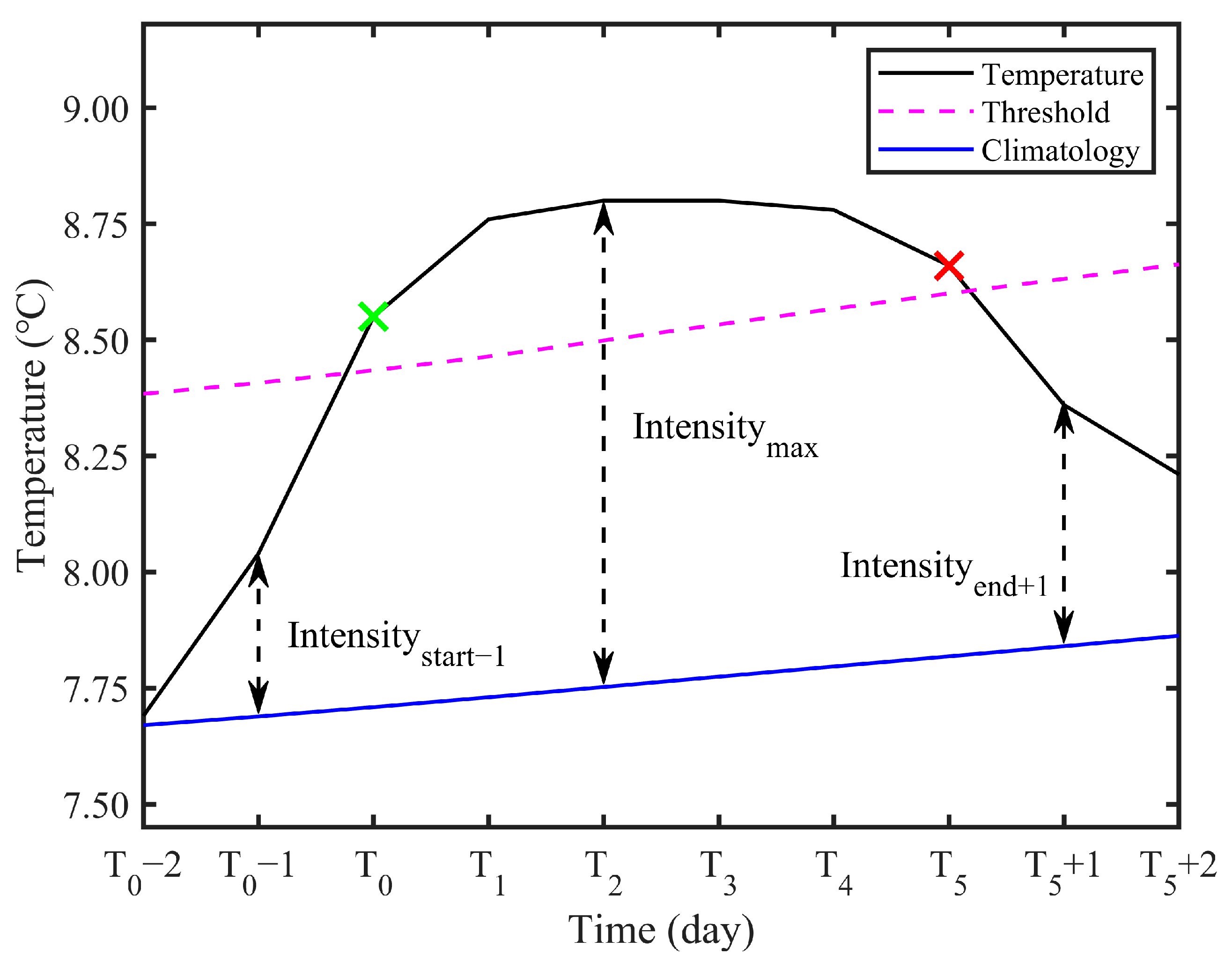

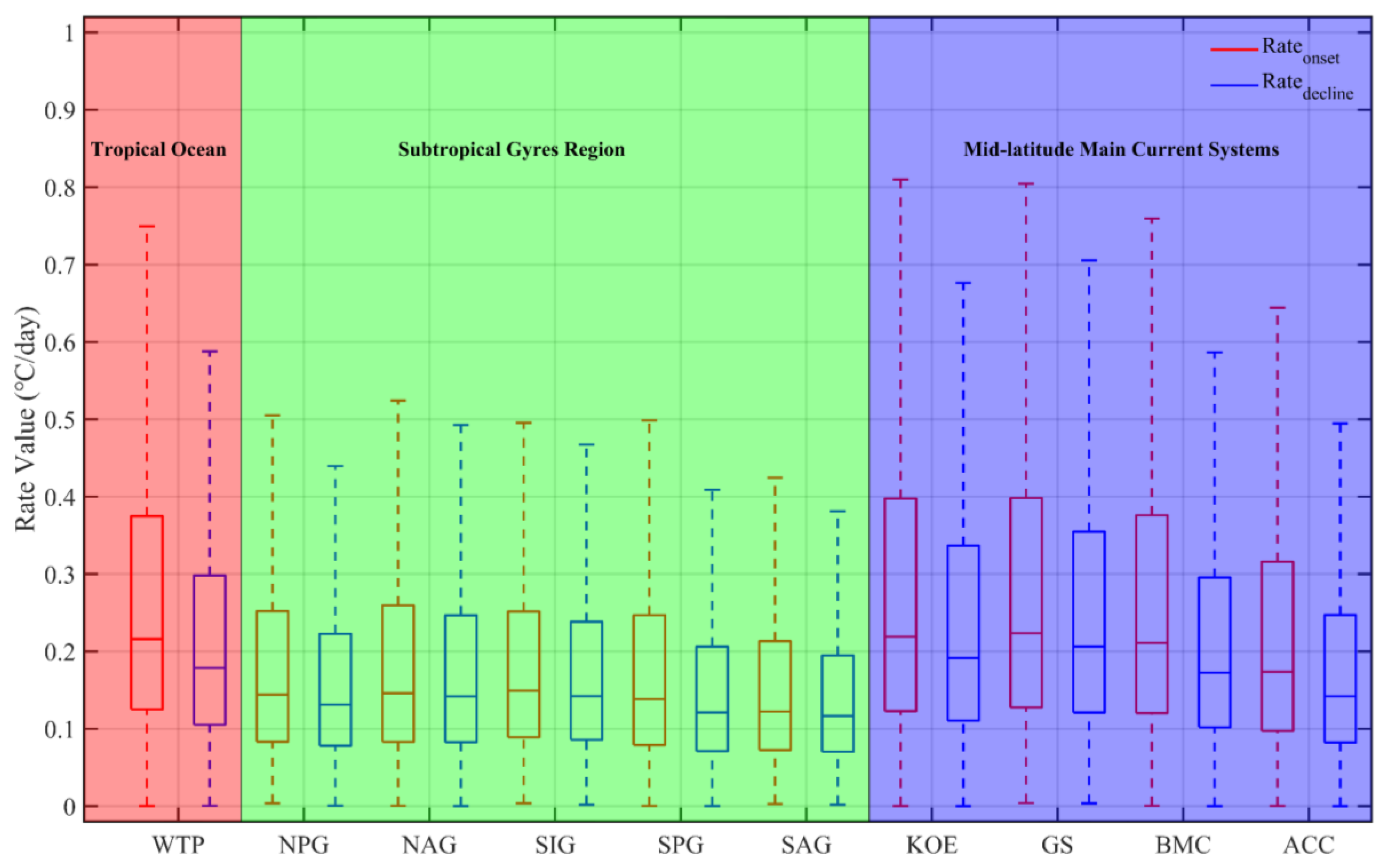


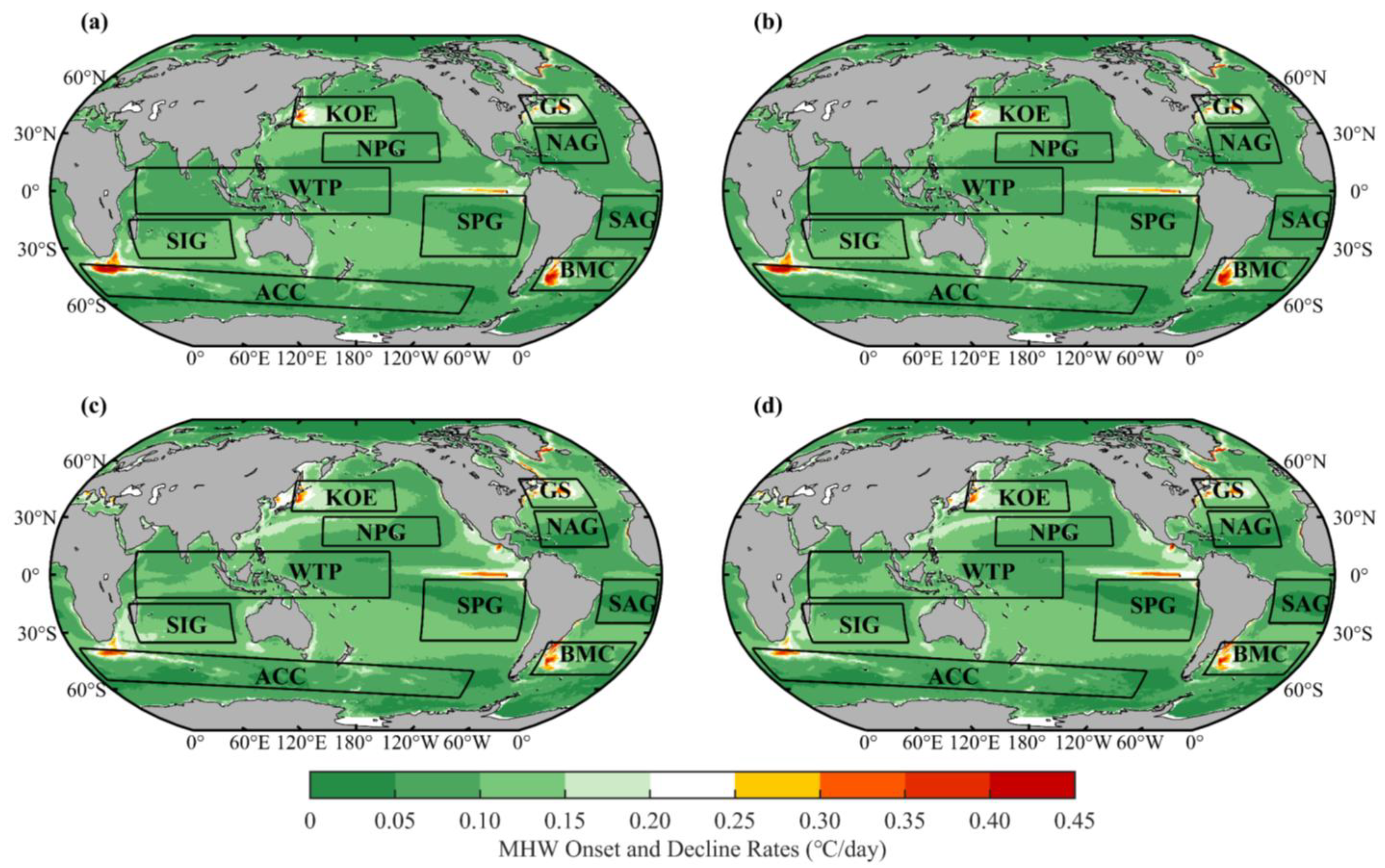
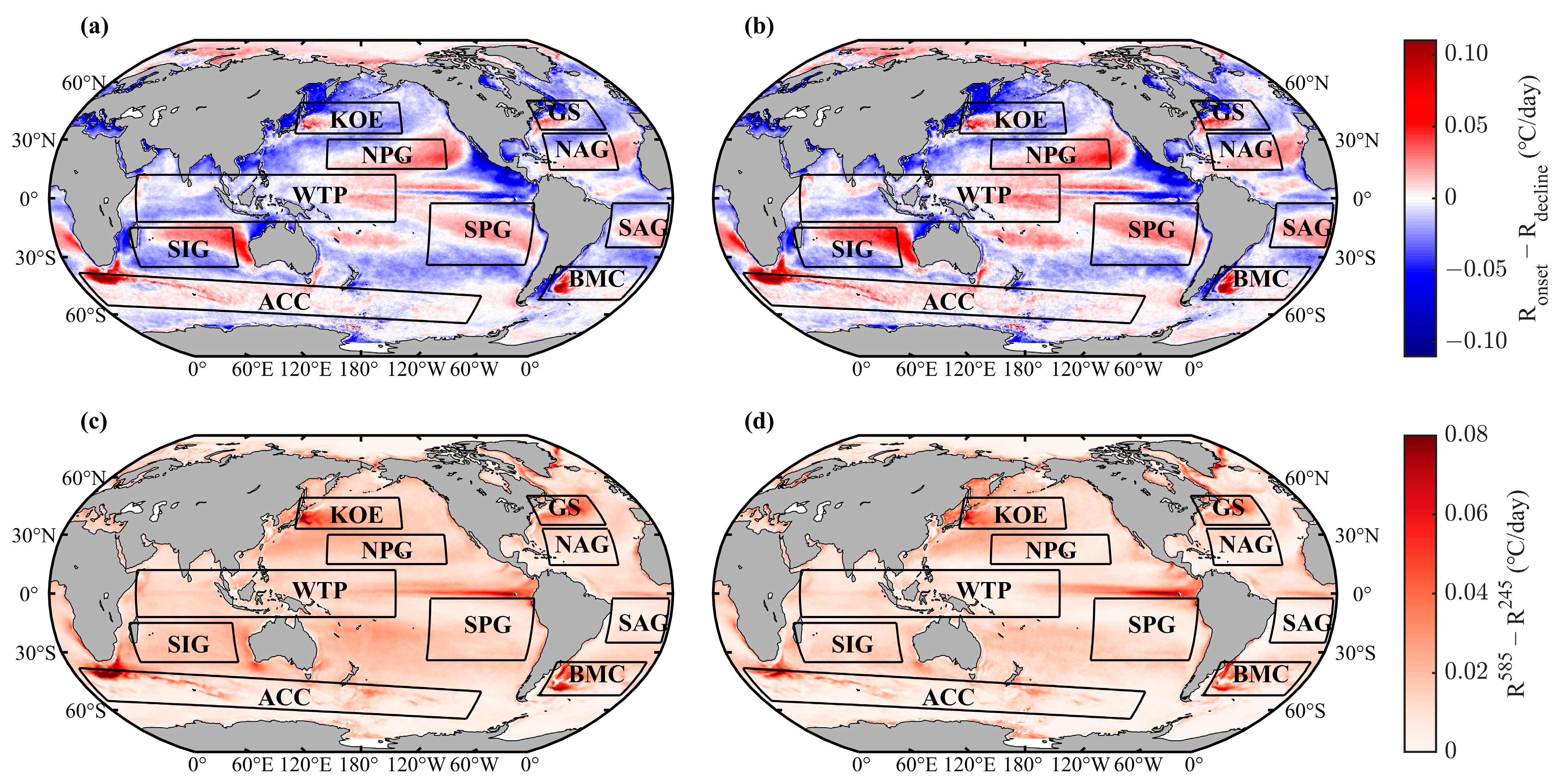
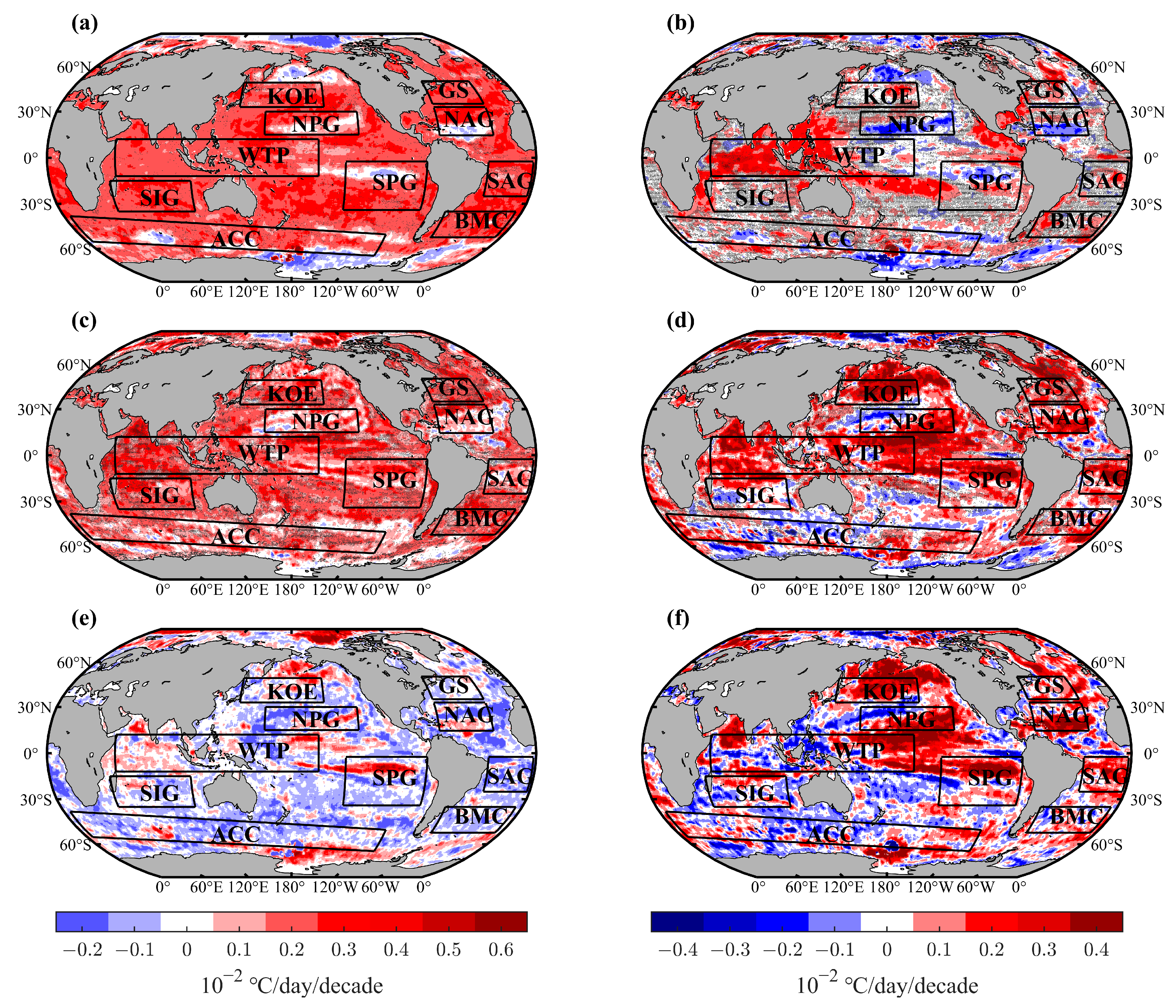

| Model | Institution (Country) | Mean Resolution (km) | Grid Number (Lon × Lat) |
|---|---|---|---|
| AWI-CM-1-1-MR | AWI (Germany) | 25 | unstructured grid |
| GFDL-CM4 | NOAA-GFDL (USA) | 25 | 1440 × 1080 |
| GFDL-ESM4 | NOAA-GFDL (USA) | 50 | 720 × 576 |
| MPI-ESM1-2-HR | DKRZ (Germany) | 50 | 802 × 404 |
| Region | Max (°C/day) | Min (°C/day) | Mean (°C/day) | Median (°C/day) | First Quartile (°C/day) | Third Quartile (°C/day) |
|---|---|---|---|---|---|---|
| WTP | 3.79 | 1.50 × 10−4 | 0.29 | 0.22 | 0.13 | 0.38 |
| 3.36 | 4.97 × 10−4 | 0.24 | 0.18 | 0.11 | 0.30 | |
| NPG | 3.18 | 3.69 × 10−3 | 0.21 | 0.14 | 0.08 | 0.25 |
| 3.27 | 6.41 × 10−4 | 0.18 | 0.13 | 0.08 | 0.22 | |
| NAG | 3.26 | 5.76 × 10−4 | 0.22 | 0.15 | 0.08 | 0.26 |
| 3.54 | 7.62 × 10−5 | 0.20 | 0.14 | 0.08 | 0.25 | |
| SIG | 3.50 | 3.70× 10−3 | 0.21 | 0.15 | 0.09 | 0.25 |
| 5.19 | 1.84 × 10−3 | 0.20 | 0.14 | 0.09 | 0.24 | |
| SPG | 4.82 | 2.48 × 10−4 | 0.20 | 0.14 | 0.08 | 0.25 |
| 2.98 | 9.19 × 10−5 | 0.17 | 0.12 | 0.07 | 0.21 | |
| SAG | 2.75 | 2.82 × 10−3 | 0.18 | 0.12 | 0.07 | 0.21 |
| 2.59 | 1.86 × 10−3 | 0.16 | 0.12 | 0.07 | 0.20 | |
| KOE | 4.35 | 1.33 × 10−4 | 0.32 | 0.22 | 0.12 | 0.40 |
| 4.62 | 2.37 × 10−4 | 0.27 | 0.19 | 0.11 | 0.34 | |
| GS | 4.68 | 4.05 × 10−3 | 0.32 | 0.22 | 0.13 | 0.40 |
| 7.08 | 3.51× 10−3 | 0.29 | 0.21 | 0.12 | 0.36 | |
| BMC | 3.83 | 4.03 × 10−4 | 0.30 | 0.21 | 0.12 | 0.38 |
| 6.33 | 4.20 × 10−4 | 0.24 | 0.17 | 0.10 | 0.30 | |
| ACC | 4.50 | 2.21 × 10−4 | 0.25 | 0.17 | 0.097 | 0.32 |
| 5.61 | 5.36 × 10−7 | 0.20 | 0.14 | 0.082 | 0.25 |
| Region | SSP245 Onset (°C/day) | SSP585 Onset (°C/day) | SSP245 Decline (°C/day) | SSP585 Decline (°C/day) |
|---|---|---|---|---|
| WTP | 0.09 ± 0.01 | 0.09 ± 0.01 | 0.09 ± 0.02 | 0.09 ± 0.02 |
| NPG | 0.09 ± 0.02 | 0.09 ± 0.01 | 0.08 ± 0.03 | 0.08 ± 0.03 |
| NAG | 0.07 ± 0.02 | 0.07 ± 0.02 | 0.07 ± 0.03 | 0.07 ± 0.03 |
| SIG | 0.10 ± 0.01 | 0.10 ± 0.01 | 0.11 ± 0.03 | 0.10 ± 0.03 |
| SPG | 0.08 ± 0.03 | 0.08 ± 0.03 | 0.08 ± 0.04 | 0.08 ± 0.03 |
| SAG | 0.06 ± 0.01 | 0.06 ± 0.01 | 0.06 ± 0.02 | 0.06 ± 0.02 |
| KOE | 0.13 ± 0.05 | 0.12 ± 0.05 | 0.14 ± 0.04 | 0.14 ± 0.04 |
| GS | 0.16 ± 0.05 | 0.15 ± 0.05 | 0.17 ± 0.05 | 0.17 ± 0.05 |
| BMC | 0.13 ± 0.08 | 0.13 ± 0.08 | 0.13 ± 0.07 | 0.13 ± 0.07 |
| ACC | 0.10 ± 0.05 | 0.10 ± 0.05 | 0.10 ± 0.04 | 0.10 ± 0.04 |
Disclaimer/Publisher’s Note: The statements, opinions and data contained in all publications are solely those of the individual author(s) and contributor(s) and not of MDPI and/or the editor(s). MDPI and/or the editor(s) disclaim responsibility for any injury to people or property resulting from any ideas, methods, instructions or products referred to in the content. |
© 2025 by the authors. Licensee MDPI, Basel, Switzerland. This article is an open access article distributed under the terms and conditions of the Creative Commons Attribution (CC BY) license (https://creativecommons.org/licenses/by/4.0/).
Share and Cite
Pan, Y.; Sun, W.; Bao, S.; Xie, M.; Jiang, L.; Ji, J.; Yu, Y.; Dong, C. Global Variability and Future Projections of Marine Heatwave Onset and Decline Rates. Remote Sens. 2025, 17, 1362. https://doi.org/10.3390/rs17081362
Pan Y, Sun W, Bao S, Xie M, Jiang L, Ji J, Yu Y, Dong C. Global Variability and Future Projections of Marine Heatwave Onset and Decline Rates. Remote Sensing. 2025; 17(8):1362. https://doi.org/10.3390/rs17081362
Chicago/Turabian StylePan, Yongyan, Wenjin Sun, Senliang Bao, Mingshen Xie, Lei Jiang, Jinlin Ji, Yang Yu, and Changming Dong. 2025. "Global Variability and Future Projections of Marine Heatwave Onset and Decline Rates" Remote Sensing 17, no. 8: 1362. https://doi.org/10.3390/rs17081362
APA StylePan, Y., Sun, W., Bao, S., Xie, M., Jiang, L., Ji, J., Yu, Y., & Dong, C. (2025). Global Variability and Future Projections of Marine Heatwave Onset and Decline Rates. Remote Sensing, 17(8), 1362. https://doi.org/10.3390/rs17081362







